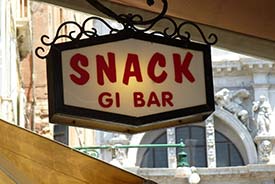|
Venice > Q&A > Food & drink
Venice Travel FAQ:
Food and Drink
From:
Venice Travel FAQ

ABOVE: An homage to the Occupation,
or to the gastrointestinal tract? Your guess is as good as ours.
-
Is it true that restaurants are expensive in Venice?
Yes and no. In many restaurants, you can run up a large bill by
ordering an a la carte meal of appetizer, primo piatto, main
course, and dessert. But the same restaurant might offer large personal pizzas
for less than the price of a pasta dish.
You can save money with the fixed-price menu turistico
or tourist menu, but the food may not be very good. (A menu turistico
shouldn't be confused with daily specials, which may be excellent dishes
prepared from whatever is in season at the moment.)
Fortunately, Italian restaurants nearly always have menus
outside the entrance, so you can check meal options and prices before going inside.
Note that some restaurants have a small coperto, or cover charge,
to cover the cost of cutlery and bread. This is an Italian tradition, and
it's entirely legitimate.
-
How can I find restaurants that don't cater to
tourists?
You can't, because no Venice restaurant can survive on local
trade alone.
Some neighborhoods are more tourist-oriented than others, of
course. Most restaurants near heavily-touristed areas such as the Piazza San
Marco, the Piazzale Roma, the railroad station, and the Rialto Bridge cater
mostly to tourists. Still, if you enjoy sitting alongside the Grand Canal with
the floodlit Ponte di Rialto as a backdrop, do you really care if the people at
the next table are from Baltimore, Birmingham, or Budapest instead of the
immediate neighborhood?
Other things to know:
-
The fact that a restaurant has a multilingual menu doesn't
mean it's a tourist trap. Venice attracts millions of foreign visitors every
year, so it makes sense for restaurateurs to display their menus in Italian,
English, and other languages.
-
It isn't uncommon for restaurant owners and waiters to
stand outside and greet
passersby in the hope of drumming up trade. There's no need to be defensive:If
you aren't interested, just say "No, grazie" and continue on your way.
-
Italian sit-down restaurants often add a "pane e coperto"
or "bread and cover charge" to the bill. This isn't a scam; it's simply
an age-old tradition.
-
Be careful when ordering items (such as fish and other
seafood) that are priced by weight. A buxom branzino or a
voluptuous lobster could prove expensive.
-
When you pay by credit card, don't include a tip. (Tip the
waiter separately in cash.) See our Money and
tipping FAQ page
for advice on when, where, and how to tip.
-
Can you recommend any specific restaurants?
We aren't restaurant connoisseurs (we
usually prefer eating at home, with our dog under the kitchen table). Still, we have published a small number of
restaurant reviews that
you're welcome to read, and our
Dining in the Veneto article is a useful introduction to Venetian cuisine.
-
How can we eat cheaply in Venice?
Venice has many snack bars, pizza-by-the-slice vendors,
and Turkish kebab shops where you can eat quickly without paying restaurant prices.
Many bakeries sell sandwiches and other prepared foods. (Durant likes the meat
pies or pasties at Majer, a local bakery-deli chain. He's also a fan of the kebab shop in a covered passage just off the Campo
Santa Margherita on the way to the Piazzale Roma.)
We're partial to the
Frito-Inn on the Campo San Leonardo in Cannaregio, where the cheerful
proprietors sell fried fish, pommes frites, and other unhealthy but
tasty food at a take-out window. (You can sit on a stool or bench or lean on one
of the stand-up outdoor tables while eating.) Outdoor
produce vendors are scattered around town. The best-known outdoor markets are
the Rialto Food Markets.
Finally, Venice has many supermarkets where you can buy
bread, cheese, lunchmeats, drinks, and prepared foods.
Tips:
-
At fruit and vegetable stalls, don't touch the merchandise.
Just point, and the vendor will wrap the items for you.
-
In produce departments at supermarkets, you'll need to (a)
put on a disposable plastic glove, (b) place your items in a plastic bag,
(c) set the bagged items on the scale, and (d) tap the picture of an apple,
orange, etc. on the scale's electronic menu to get a printed label.
-
When ordering cold cuts and other bulk items at a deli
counter, tell the clerk how many "etti" you want. (An etto
is 100 grams, or slightly less than a quarter of a pound.) Example: Asking
for "due etti, per favore" will get you 0.2 kg or just under half a
pound.
-
Where can we have a picnic in Venice?
Officially, it's illegal to loiter in the street or in public
parks while eating, but you're unlikely to be told to move on as long as you
observe three cardinal rules:
-
Don't picnic or sit in the Piazza San Marco.
-
Don't picnic or sit on bridges and church steps.
-
Don't drag out a picnic blanket and hamper. (Just nibble
your sandwich as a local might do, and remember to toss your litter in a trash
receptacle.)
-
What do I need to know about bars in Venice?
These tips may help:
-
In Italy, the word "bar" and "café"
are interchangeable. To make matters even more confusing, a pastry shop or
pasticceria may double as a bar (which is convenient if you like a
shot of grappa in your morning coffee or a cream puff with your late-night
lager.)
-
In traditional bars, you pay the cashier for your drink or
coffee, get a ticket, and present the ticket to the bartender or barista when you're drinking at the bar. If you want
to sit down, you find a table, sit, and place your order with a waiter
or waitress. But: Not all bars and cafés observe
this procedure, so check out the scene and act accordingly.
-
In most bars and café, you'll pay higher prices for
table service than at the bar.
-
Older Venetians may order an ombra (a glass of
wine), but the younger crowd's favored drink is the spritz, which
is a mixture of chilled prosecco fizzy white wine, sparkling
mineral water, and a bitter liqueur such as Aperol, Cinzano, or Cynar.
-
Can you recommend any gelato shops?
If you have a sweet tooth (as we do), there's no such thing as
truly bad gelato, but some gelaterie are better than others.
Here are four of our favorites:
-
Our Venetian acquaintances claim that
La Boutique del Gelato
is the best
gelateria in Venice. We like it for the quality of the ice cream, the
portions, and the friendliness of the staff. La Boutique del Gelato is on
the Salizada San Lio, next to the Hotel Bruno.
-
Il Doge, near the
southeastern corner of the Campo Santa Margherita, has the best limone
gelato in Venice: tart, and extremely refreshing on a hot day. We like to
take our coni to one of the red wooden benches in the square, where
we can enjoy our gelato while watching dogs and ducking as children's soccer
balls arch over the campo.
-
Alaska
(see our
blog post) is a gelateria with a difference: Exotic flavors such as
zenzero (ginger), cardomoma (cardomom), and carciofi
(artichoke) often turn up in the display case. In summer, the menu includes
several flavors of granita--often served with a basil leaf.
-
La Mela Verde, on the
Fondamenta de l'Osmarin in Castello (slightly east of the Piazza San Marco).
The signature green-apple gelato is excellent on a hot day, but the other
flavors are equally good--especially the incredibly dark and rich
cioccolato.
Tip: If you're in line at a gelateria and the person ahead of
you is handed a cone with a tiny dollop of gelato, go somewhere else. (We avoid
Rosa Salva, on the Campo SS. Giovanni e Paolo, which is popular with tour groups
but skimps on portions.)
Yes. Nearly every square has a fountain where you can
fill your
water bottle, wash your hands, or bend over to get a drink from the spigot or
faucet. (Often, you'll find a trough or pan for your dog above the drain.)
Don't waste money on bottled water in Venice: The public tap
water is safe, cold, and great-tasting. It's piped in from deep wells on the
Italian mainland, and it's so good that it has its own brand name:
Acqua Veritas.
Next page:
Sightseeing and local tours
About the author:
 Durant Imboden has
written about Venice, Italy since 1996.
He covered Venice and European travel at About.com for 4-1/2 years before launching
Europe for Visitors (including
Venice for Visitors) with Cheryl
Imboden in 2001. Durant Imboden has
written about Venice, Italy since 1996.
He covered Venice and European travel at About.com for 4-1/2 years before launching
Europe for Visitors (including
Venice for Visitors) with Cheryl
Imboden in 2001.
PC Magazine has called this "the premier visitors'
site for Venice, Italy." Over the years, it has helped more than 30 million
travelers. For more information, see About our site,
our Europe for Visitors
press clippings,
and
our reader testimonials.
| |
|

